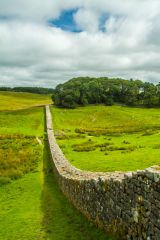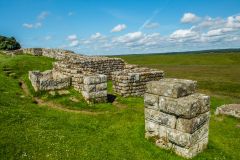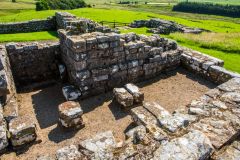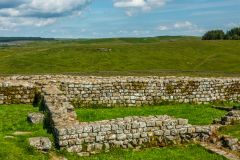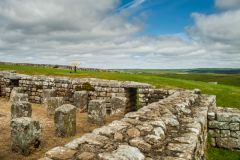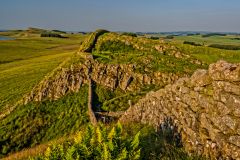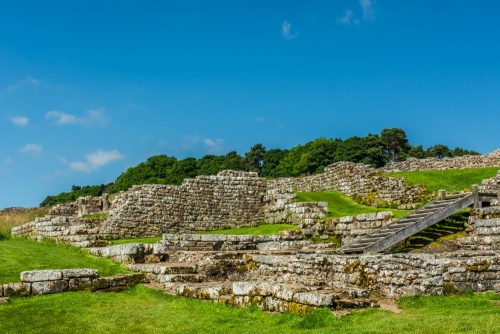
Housesteads is the best preserved of the thirteen permanent Roman army posts along the length of Hadrian's Wall, the famous barrier built to keep the northern tribes out of the settled Roman south.
History
The fort stands about midway along the Wall, and is easily the most complete Roman military fort in Britain. We do not know exactly when the fort was begun, but the Wall itself was built from AD 122 and construction on Housesteads must have started within a decade. A vicus, or civilian settlement, later grew up around the military fort.
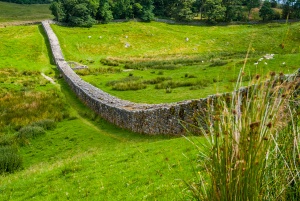
Interestingly, the fort was built before the wall in either direction was complete. The fort is very large, covering 2.2 hectares, and was designed to hold a cohort, a garrison of 800 auxiliary troops drawn from around the Empire.
We do not know which garrison was originally stationed here, but from the late 2nd century it was manned by the 1st cohort of Tungria, drawn from the region around Tongres, in modern Belgium. The Tungrian cohort was moved to Housesteads from the nearby fort of Vindolanda.
Housesteads was one of 15 forts along the length of the Wall, and seems to have been occupied continuously until the 4th century. Hadrian's successor, Emperor Antonius Pius, erected an earthwork wall well into what is now Scotland, and most of the Tungrian cohort seems to have moved north to garrison Castlecary Fort on the Antonine Wall, but part of the cohort stayed here at Housesteads. The Antonine Wall was abandoned in AD 160 and for the next 200 years Housesteads was manned at full strength.
From the late 2nd century the fort was expanded, with construction of an impressive house for the commandant, or commanding officer. A granary was also built, though the barracks were left unchanged. Several other units came to Housesteads in the early 3rd century, including a troop of mercenary soldiers known as the numerus Hnaudifridi. Another unit arrived from Frisia, in northern Holland, bringing with them their distinctive pottery, samples of which can be seen in the site museum.
From the late 3rd century the garrison was reduced in size, the defences strengthened, and the civilian settlement was abandoned. It is possible that the civilians simply moved inside the fort for safety. The last find of a datable inscription comes from about AD 300, so it seems that the garrison either left or was greatly diminished in size and importance.
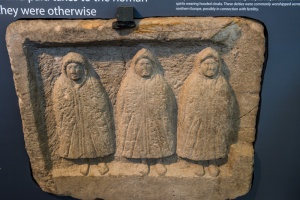
In the 16th century the crumbling Roman ruins were used by thieves and cattle-stealers, many from the local Armstrong family. The site gained a evil reputation, and wise travellers avoided the area. It was only in the 18th and 19th centuries, when antiquarians began to popularise exploration of heritage sites, that visitors began to return.
What to see
- Roman loos
- Barracks Block
- Commandant's house
- Finds from the fort inside the modern museum
- Walks along Hadrian's Wall
Perhaps the most famous find at Housesteads was the 3rd century Genii Cuculatti, a carving of three figures in hooded capes. These odd figures were a form of household gods, and the carving was erected in a small temple at the rear of one of the houses in the civilian settlement, or vicus, that grew up around the fort.
Another find on display is a piece of a pottery bowl, inscribed with the name 'Neuto', suggesting that the owner was a soldier from what is now Holland or Belgium.
There are fabulous walks along the Hadrian's Wall path in both directions from Housesteads, and a large car park on the B6318. The parking price is rather steep, but you can then use the parking ticket to stay at other major car parks along Hadrian's Wall for free during a 24 hour period. The modern visitor centre is beside the car park, but from there it is a stiff climb up to the site museum and the fort itself.
About Housesteads Fort (Hadrian's Wall)
Address: Haydon Bridge,
Hexham,
Hadrian's Wall,
Northumberland,
England, NE47 6NN
Attraction Type: Roman Site
Location: off B6318
Website: Housesteads Fort (Hadrian's Wall)
English Heritage - see also: English Heritage memberships (official website)
Location
map
OS: NY797 686
Photo Credit: David Ross and Britain Express
HERITAGE
 We've 'tagged' this attraction information to help you find related historic attractions and learn more about major time periods mentioned.
We've 'tagged' this attraction information to help you find related historic attractions and learn more about major time periods mentioned.
Historic Time Periods:
Find other attractions tagged with:
16th century (Time Period) - 2nd century (Time Period) - 3rd century (Time Period) - 4th century (Time Period) - Roman (Time Period) -
NEARBY HISTORIC ATTRACTIONS
Heritage Rated from 1- 5 (low to exceptional) on historic interest
Hadrian's Wall - 0 miles (Roman Site) ![]()
Sewingshields Roman Wall (Hadrian's Wall) - 1.4 miles (Roman Site) ![]()
Vindolanda Roman Fort - 2.4 miles (Roman Site) ![]()
Allen Banks & Staward Gorge - 2.8 miles (Countryside) ![]()
Winshields Roman Wall (Hadrian's Wall) - 2.9 miles (Roman Site) ![]()
Haydon Bridge Old Church - 3.5 miles (Historic Church) ![]()
Carrawburgh Temple of Mithras - 4.1 miles (Roman Site) ![]()
Mare and Foal Standing Stones - 4.4 miles (Prehistoric Site) ![]()
Nearest Holiday Cottages to Housesteads Fort (Hadrian's Wall):
Haydon Bridge, Northumberland
Sleeps: 4
Stay from: £764 - 3154
Haltwhistle, Northumberland
Sleeps: 4
Stay from: £273 - 1015
More self catering near Housesteads Fort (Hadrian's Wall)
